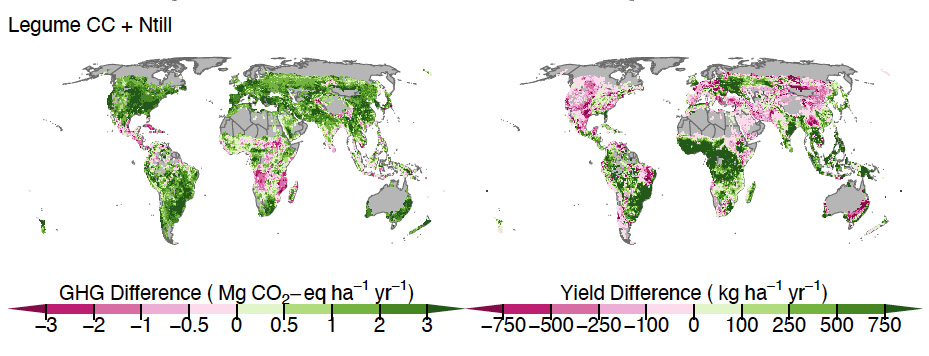Research pinpoints where regenerative agriculture practices like planting cover crops and avoiding tillage can have the most benefits for climate change mitigation and crop production.
The Gist
The challenge at the heart of climate change mitigation strategies on the world’s croplands is this—how to balance the need for carbon sequestration with the need for increased yield on the same amount of land.
A new modeling study, published in Nature Climate Change, finds that improved soil management through regenerative agricultural practices primarily supported either greenhouse gas mitigation or higher crop yields, but not necessarily both goals in the same place. However, the study also showed that in some places, regenerative agriculture could achieve both improved crop yield and climate mitigation.
Co-authored by Nature Conservancy scientists Deborah Bossio and Stephen Wood along with experts from New York University, Cornell University and the Environmental Defense Fund, the paper pinpoints where regenerative agricultural practices, like planting cover crops and avoiding tillage, can have the most simultaneous benefits for climate change mitigation and crop production through the year 2100.
A key goal of regenerative agricultural practices is to provide the broadest possible opportunity for both crop yield and climate outcomes and this study identifies regions across the globe where meeting both needs are most promising. For example, legume cover crop combined with no-till farming could produce win-win scenarios in places like Africa, Latin America, the US Corn Belt, and the North China Plains.

The Big Picture
Other important contributions of the study, the authors say, are its modeling approach that included total greenhouse gas accounting, and the identification of soil management strategies that maximize climate benefits without severely compromising crop yields or vice versa—which could inform future decision-making.
The authors examined multiple regenerative practices—cover crops, no-tillage, and crop residue management—at a global scale through the year 2100 and compared them to typical conventional practices. One of the benefits of this lengthy time horizon is that it includes climate data that may give a more relevant long-term assessment than an empirical meta-analysis based solely on current climate conditions. One of the weakness, however, of a long-term time horizon is that there is not a lot of data on the long-term impacts of these practices that models can be calibrated to; and, there is high uncertainty around what climate change will be like by 2100.
“The good news is that we now have a better understanding of which regenerative practices are suited to which locations,” notes Dominic Woolf, the project’s principal investigator at Cornell University and senior author of the study. “The bad news is that, since not all regenerative practices are well suited to all conditions around the world, the potential for climate benefits is much lower than predicted by previous studies that do not consider these complex tradeoffs.”
The Takeaway
Ultimately, like all things related to climate change and food production, the best outcomes require a delicate and constantly shifting balancing act. According to researchers, global food and animal feed demand is predicted to grow more than 50% over the next three decades. So the greatest climate change mitigation opportunity is to ensure this growth occurs on current croplands to avoid deforestation and other land use changes that release additional CO2 to the atmosphere.
“One of the key advances of this paper is it helps us identify areas where there are likely to be win-wins between carbon storage and crop production, and areas where there might be trade-offs,” observes Stephen Wood, TNC scientist and one of the co-authors of the study. “That helps us better target technical and extension advice on regenerative agricultural practices to farmers to best achieve both climate and yield benefits.”
This study is incorporated into Naturebase, which allows decision-makers to see the latest and best available data about opportunities for nature-based solutions to climate change around the world.



